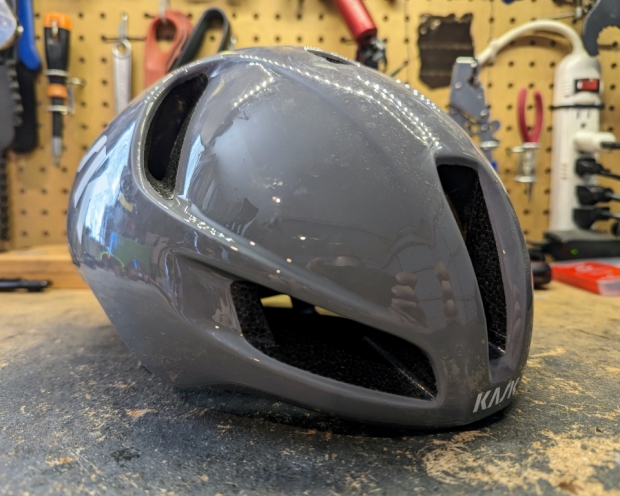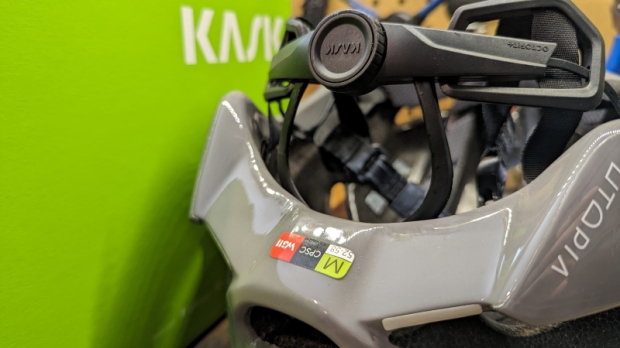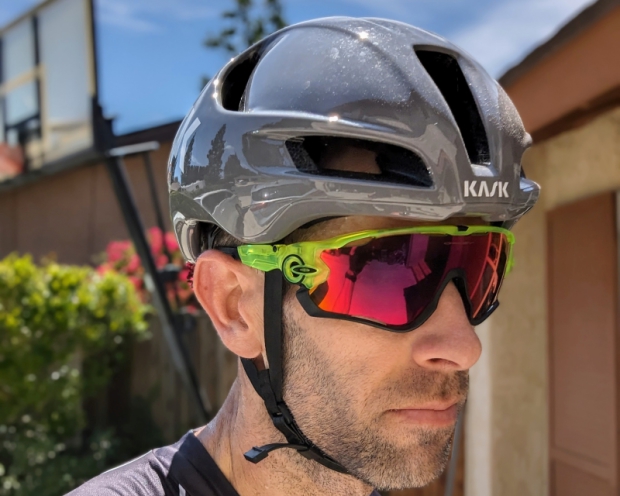KASK Utopia Y: Race Day Aero. Every Day Comfort.

The influence of the Team Sky/Ineos partnership on the technical direction of both KASK and, especially, Pinarello has precipitated two of the most astonishing shifts in engineering excellence within the sport of cycling. These were not brands that were known for absolute technical innovation, in particular with regards to aerodynamics. But, like the pinnacle brand of Italian engineering-meets-style – Ferrari, both KASK and Pinarello have kept their flair while blossoming into two of the most innovative and engineering driven brands in all of sport.
Notably, Bradley Wiggins chose a British Cycling track helmet over any KASK model when he set the hour record aboard a Pinarello designed with Jaguar providing much of the aerodynamic expertise. Contrast that with both Dan Bigham and Fillipo Ganna decimating that record while clad in an off-the-shelf KASK helmet and aboard Pinarello track bikes that, at least outwardly, were the byproduct entirely of in-house engineering, albeit with Bigham's considerable input and insight.
KASK's helmets have always been comfortable and stylish. But they now boast some of the best aerodynamics of any helmet brand. I've always been a fan of aero-road helmets, ever since I raced in the first real entry into the category – the Specialized Evade – back in 2013. In particular, I think aero-road helmets are often the best choice for age-group athletes, where awareness on a crowded course and the physical strain of keeping a longer tail helmet tight against the back for a very long ride offset any potential aero losses. Aero road helmets also are generally notably lighter than dedicated TT helmets, which in my experience makes a meaningful difference on the run. I was shocked to discover how much better I felt running after cycling in an aero road helmet, as my upper back and neck were just that much less fatigued.
While the narrative around road helmets during Ironman has largely focused around "heat management" – especially in Kona, in my opinion the weight discrepancy is the most impactful. It's hard to measure the impact of neck and back fatigue on posture, and then the effect of posture on running, but in my own experience, it was meaningful. When you factor in the added awareness that comes with a helmet that does not cover your ears and impair your hearing, aero road helmets really become incredibly compelling as race-day options. As their aerodynamics have continued to improve – though there is so much variance with regards to head position that I think it's probably a fool's errand to try to quantify it too deeply, there's even less reason to choose a TT helmet for long course racing.

Fit
Fit has always been KASK's strongest feature. I have always been able to wear KASK helmets tighter because fit is so good. This adds a sense of confidence around safety, since the helmet manages to hug my head without digging in. While I wear other helmets so that they don't move much, I can wear a KASK so that it doesn't move at all.
In particular, KASK's faux leather chin strap is just better than the nylon webbing found on virtually every other brand. Again, you can keep this strap more snug and it never digs in or disturbs you. I realize that head shape varies, but in my experience with multiple KASK helmets, the fit on all of them is superb. Maybe that's just my head shape, but in talking with other riders, it is a consistent theme. KASK gets fit right.
The retention system is superb – especially in terms of fitting glasses. You can fit the end of the stem of your glasses under the cradle (the plastic "web" of the retention system – the part minus the dial) to help keep them secure, but the cradle has a slight outward flair to prevent it from tightening the stems into your head. You don't need to loosen the cradle to keep your glasses secure. Again, it's a small detail but it matters. The Utopia Y fits so well riding around that I have that much more confidence that it would stay put and do its job in the event of a mishap.
While I found the Utopia Y to be nearly flawless – it's a joy to wear and has easily taken the role of my every-ride helmet – the vertical adjustment system is … odd. The height of the dial adjustment system at the back can be moved up or down very easily. Too easily I think, though I'm increasingly ambivalent. The helmet moves a bit up and down when making large movements of your head – say you stand and look back as you might as a stop light. In these cases, the helmet notably shifts a bit. Some of this is likely – certainly – because as I said I wear KASK helmets tighter because the overall fit is so good, but comparing the vertical adjustment to other helmets I have, it's clearly designed to shift more easily. Now, that also might be by design, since maybe part of that comfort comes from the helmet's ability to move when you make large movements of the head and neck. I increasingly think this is likely, because this movement never happens while you are actually riding. Nevertheless, feeling the vertical adjustment shift in certain moments does take a bit of getting used to. At first, I thought something was wrong with the helmet, but as I've worn it for more miles – I've got somewhere between 500 and 1000 miles in the Utopia Y since receiving it, I've largely forgotten it or at least just gotten used to it given how much I like the helmet overall.
This is a new retention system – it is really the primary change from the original Utopia to the Utopia Y. But having not ridden in the original Utopia, I can't speak with any certainty to what exactly might have changed (or not). Overall, I found the new OCTOFIT+ system to be very comfortable and functional, aside from the somewhat unexpected – but not necessarily problematic – movement of the vertical adjustment in very specific circumstances.

Function
Because there's so much variance and individuality, I didn't set out to try to quantify the speed of the KASK Utopia. I can, however, say that it's "fast." I am a creature of habit, and I have thousands – tens of thousands – of miles on my favorite local routes. At comparable wattage, I recorded some of my fastest times on my most regular routes in the Utopia Y at comparable wattage to what I ride normally. I'd say the helmet is at least comparable with my old Scott Cadence, which tested fast enough that uber-cyclist Sebastian Kienle chose the Cadence as his race-day helmet for Kona in 2016. I would say the Utopia was faster for me, but the pure aerodynamics is not really the focus of this review. KASK has proven with their pure TT/Track helmet that they understand aerodynamics. And I think that's earned them some trust when it comes to overall helmet design. The Utopia Y is, generally speaking, "fast." I'll stand by that but nothing in more explicit detail. Helmets are just too individual. Even if I was to take it to the velodrome, I don't know what that would meaningfully add to this review.
From a "how cool is it" perspective, I'd say it is marginally worse at low speeds than a heavily vented "climbing" helmet, but it is significantly better at high speeds because of consciously directed airflow. At low speeds, air often has no trouble flowing through even poorly designed vents. But at higher speed, thoughtful aerodynamics makes a difference. It's often faster to direct air through the helmet – and over your head – than around the helmet.
It's especially notable how obvious the changes in airflow are when turning your head to look behind or to the side. It's most obvious how effectively the Utopia directs airflow in your normal riding position when you deviate from that position. You can feel the vent on the leeward side of your head completely stall out – no air flows through it at all – when your head is turned, and then immediately feel the airflow return when you straighten your head.

Flair
No discussion of an Italian helmet would be complete without talking at least a bit about style. The Utopia Y looks good. Well, at least as good as any large styrofoam hat can. The flat gray that's all the rage on high ends cars currently has grown on me. I chose it for some fun after many years of white helmets, and I think it looks distinct. White is still my slight preference for racing, though I'll admit it likely doesn't really matter. The quality of the flat gray with its gloss finish is very good. What you'd expect from a premium helmet with a premium price tag. The overall cut and silhouette of the helmet is also very nice. It's a helmet that lends itself to selfies, for whatever that is and isn't worth.

Safety
A section on safety might seem like an obvious necessity for a review of helmets, but I almost didn't include this. My rationale is that discussions around safety "features" tend to stray too far into the unknown realm unless that's the explicit focus of the piece. I can give some semi-objective feedback on aerodynamics just from experience on regular routes and power data. But even there, I don't want to pretend to offer data that I don't have. On the safety side, I have literally nothing to offer. The helmet meets all the standards you'd expect – EN, CPSC & AS/NZS. KASK has their own testing protocol that they go over on their website – kask.com/en/safety, but I'd not want to speak to it any further than making you all aware of it.
Further, while the Utopia Y has not (yet) been tested, KASK helmets have tested well in Virginia Tech's protocol, and they have a 5-star helmet in the even-newer (and more expensive) Elemento. The much older Valegro scores 3-stars. For more on Virginia Tech's helmet testing, visit their site – helmet.beam.vt.edu
I had no concerns that the Utopia Y would protect my head as well as any helmet and, given what I believe is remarkable attention to detail on fit, I actually have more confidence because the helmet fits so well.
Conclusion
When spending $300 on a helmet, there are understandably expectations that come along with that. The Utopia Y ticks all the boxes in terms of comfort and, as best as I can tell or would vouch for with something as individual as helmets, aerodynamics. If KASK's helmets fit your head shape, the Utopia Y would be an excellent choice for long course racing. It's light, very comfortable, and shows the meat of KASK's increasing focused on engineering performance and excellence.
The price point doesn't really make sense for a training helmet – though there's nothing wrong with enjoying free speed in training, but the economics certainly change when that's the price for an everyday helmet that also can – and should – be a first choice for race day as well.
Jordan Rapp is the Chief Technology Officer at Slowtwitch.com. He holds a BSE in Mechanical & Aerospace Engineering from Princeton University. He was a professional triathlete for over 10 years and is the 2011 ITU Long Distance World Champion and a 6X IRONMAN winner.
KASK provided the helmet for this review. For more information on the Utopia Y, visit KASK.com


Start the discussion at forum.slowtwitch.com